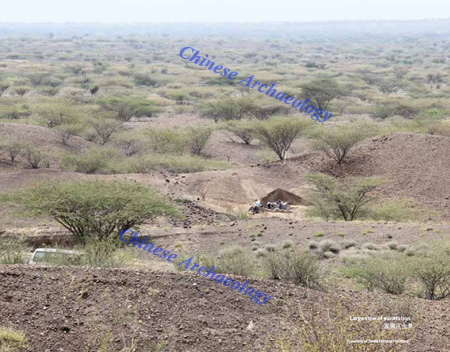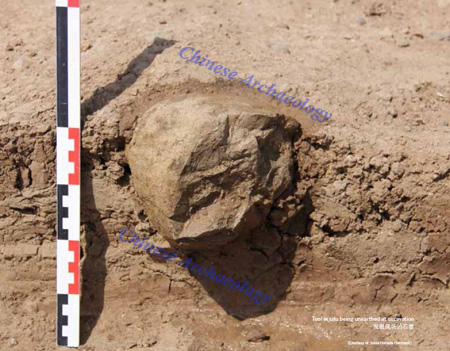The Dawn of Technology: 3.3-million-year-old Stone Tools from Lake Turkana, Kenya
From:Chinese Archaeology NetWriter:Sonia Floriane HarmaDate:2015-12-21
Conventional wisdom in human evolutionary studies has assumed that the origins of hominin stone tool production were linked to the emergence of the genus Homo in response to climate change and the spread of savannah grasslands. In 1964, fossils looking more like the later Homo genus than australopithecines were discovered at Olduvai Gorge (Tanzania) in association with the earliest known stone tool culture, the Oldowan, and so were assigned to the new species: Homo habilis or ‘handy man’. The premise was that our lineage alone took the cognitive leap of hitting stones together to strike off sharp flakes and that this was the foundation of our evolutionary success.
Large view of excavation.
In 2011, the West Turkana Archaeological Project (WTAP) began new archaeological surveys and excavation in the Lomekwi Member in the Nachukui Formation (west of Lake Turkana, northern Kenya) to search for evidence of early hominin lithic behaviour. In May 2015, the WTAP announced the discovery of Lomekwi 3, a 3.3 Ma old archaeological site where in situ stone artefacts occur in spatiotemporal association with Pliocene hominin fossils in a wooded palaeoenvironment. These finds occur in the same geographic and chronological range as the paratype of Kenyanthropus platyops (KNM-‐ WT 38350), and other hominin fossils generally referred to cf. K. platyops. The chronological context of LOM3 derives from correlation with the Lomekwi Member of the Nachukui Formation and radiometrically dated tuffs within it, as well as from magnetostratigraphy of the site and estimated sedimentation rates.
The LOM3 site is a low hill eroded into by a small ravine. Sealed in situ in Pliocene sediments, the LOM3 archaeological material is considered to be in a slightly re-distributed primary archaeological context. Precise interpretation of site preservation is based on observations drawn from the excavation, with the most plausible possibilities limited to either good preservation of the site and most of the assemblage, or a slight redistribution in close proximity to the original activity location. Based on the lithic material recovered in2011 and 2012, the current total assemblage (n = 149 surface and in situ artefacts) incorporates 83 cores, 35 flakes (whole and broken), seven passive elements or potential anvils, seven percussors (whole, broken or potential), three worked cobbles, two split cobbles, and 12 artefacts grouped as indeterminate fragments or pieces lacking diagnostic attributes. Basalts and phonolites are the dominant raw materials represented, followed by trachy-phonolite, all of which were available in local paleo-channels. Initial survey of a conglomerate source less than 100m from the site shows that cobbles and blocks of all sizes were available locally, from which the largest were consistently selected.

Tool in situ being unearthed at excavation
LOM3 cores and flakes bear all the techno-morphological characteristics of debitage products. LOM3 knappers were able to deliver sufficient intentional force to repeatedly detach series of adjacent and superposed unidirectional flakes, sometimes invasive, and then to continue knapping either by laterally rotating the cores or by flipping them over for bifacial exploitation. However, though multiple flakes were successfully detached, the majority of flake scars terminate as hinge and step fractures. The precision of the percussive motion was also occasionally poorly controlled, as shown by repeated impact marks on core platforms caused by failed blows applied too far from the striking platform edge to induce fracture. The dimensions and the percussive-related features visible on the artefacts suggest the LOM3 hominins were combining core reduction and battering activities and may have used artefacts variously: as anvils, cores to produce flakes, and/or as pounding tools. The use of individual objects for several distinctive tasks reflects a degree of technological diversity both much older than previously acknowledged, and different from the generally unipurpose stone tools used by primates. The LOM3 assemblagecould represent a technological stage between a hypothetical pounding oriented stone tool use by an earlier hominin and the flaking-oriented knapping behaviour of later, Oldowan toolmakers. The LOM3 stone tools mark a new beginning to the known archaeological record, now shown to be more than 700,000 years older than previously thought. Dating to before the earliest known fossils attributed to Homo at 2.8 Ma, the LOM3 tools raise new questions about the mode and tempo of key adaptations in the hominin lineage and lead to renewed investigation on the timing of the emergence of human-like manipulative capabilities in early hominins and implications for reconstructing cognition.
Sonia Floriane Harmand
Dr. Harmand is an Associate Professor in Anthropology at the University of Stony Brook and co-Director of the West Turkana Archaeological Project. Dr. Harmand is an expert in Early Stone Age archaeology. Her research program revolves around the central theme of how, when and why did stone tool manufacture and use originate among hominins. Since 1998, she has focused her research on reconstructing the genesis of hominin technology, a period for which the archaeological record is meager. In 2011, her annual field expedition in northern Kenya yielded the earliest archaeological site known, dated at 3.3 million years. In addition, Prof. Harmand, along with her team, is exploring the biomechanics involved in the making and possible use of stone tools. She is also currently collaborating with primate archaeologists. Prof. Harmand worked as a Research Scientist at the Centre National de la Recherche Scientifique (CNRS) in France from 2009 to 2012.
(Sonia Floriane Harmand Stony Brook University)
(Source: Research Center for World Archaeology, Shanghai Academy)

